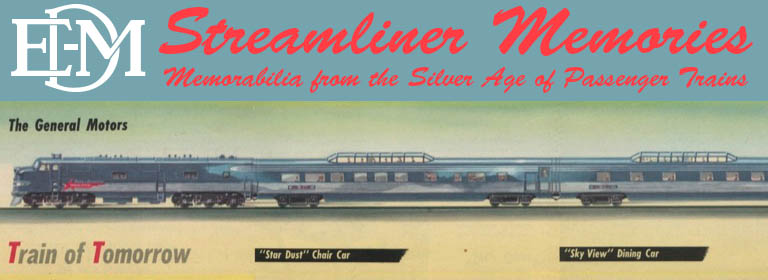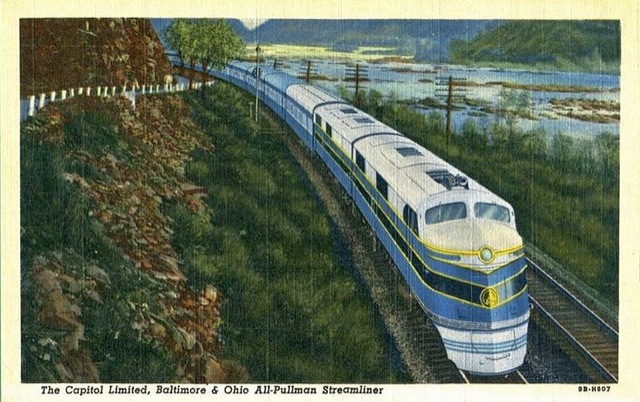When the Great Northern introduced the 1947 Empire Builder with much fanfare, General Motors helped with its own orange-and-green brochure advertising the locomotives used on the train. “On America’s crack trains, together with newly developed streamlined passenger cars,” the GM Diesel “brings an entirely new concept of high-speed operation over today’s modern routes of travel,” said the brochure.

Click image to download a PDF of this brochure.
General Motors got into the locomotive business in a fairly roundabout way. It all started when a GM executive, Charles Kettering, needed a motor for his yacht that was larger than anything GM made. He was so impressed by the engines made by a Cleveland company called Winton that he persuaded GM to buy Winton in 1930.
Winton’s large engines were used in both maritime and stationary applications. Winton also teamed up with another Cleveland company, the Electro-Motive Corporation (EMC), to make a engines for motorcars, which many railroads used for local passenger service. Unlike internal combustion engines, which are most powerful at a narrow range of revolutions per minute, electric motors are powerful over a broad RPM, and so don’t need mechanically complex multi-speed transmissions. They could be combined with internal combustion engines that would generate the electricity.
The first Winton-EMC motorcars used gasoline engines, but a couple of fires persuaded Winton that gasoline was too volatile. They then tried distillate oil, but the viscous oil gummed up the spark plugs. This led them to try Diesels, which didn’t use spark plugs. As previously noted, in 1933, when Union Pacific planned the first streamliner, it used a distillate engine while the Burlington took the risk of using a Diesel.
The Diesel turned out to be clearly superior, but the Winton Diesels were still less than perfect. As Charles Kettering’s son, Eugene, later noted, the dipstick worked fine but General Motors eventually had to redesign everything else. In 1938, General Motors developed the 567 Diesel (567 cubic inches per cylinder), which proved to be not only more reliable but powerful enough for both passenger and freight service.
The locomotive powering the Empire Builder was an E7, which was actually the eighth (or ninth, depending on how you count) in General Motors’ E series of Diesels. I’ve covered many of these before, but here is a brief review.
- The first were what General Motors called “B-B” locomotives, which were pairs of locomotives powered by two 900-HP, 12-cylindar 201-A Diesel engines. These units were mechanically the same as the later EA through E2 but their bodies had not yet been styled by Harley Earl‘s GM styling section. The B-Bs included the B&O 50, the Santa Fe 1, and (with bodies by Budd) the locomotives for the Twin and Denver Zephyrs.
- Next came the EA and EB, mechanically similar to the B-B but with a sleek, streamlined body. The only buyer was the Baltimore & Ohio, not because the locomotive was unpopular but because GM at this time changed its designation with every minor change in specifications.
- Santa Fe’s E1 and the City train’s E2s, for example, were virtually identical to the EA except for cosmetics.
- The E3, however, represented a major upgrade. It used a 12-cylinder version of General Motors new 567 Diesel engine, which produced 1,000 horsepower. Two of these in the E3s made them 2,000-HP locomotives. GM sold E3 to six different railroads, showing that it was transitioning from customizing the locomotives for each order to building standardized models.
- The E4 was identical to the E3 but included a pneumatically operated door in the nose. Seaboard was the only railroad to purchase E4s.
- The spectacular E5 was also a custom job, identical to the E3 and E4 except the body was of stainless steel. Burlington wanted more shovel-nozed locomotives to power its zephyrs, but crew worries about safety issues combined with the savings from using GM’s standard body style persuaded the Burlington to go to the E body. However, it painted an artificial grill on the nose to make it look like one of the shovel-nosed engines.
- With the E6, General Motors had completely standardized its locomotive. Purchased by nearly a dozen railroads, the E6 had only minor internal upgrades to the E3.
Meanwhile, in 1939, General Motors introduced the FT locomotive, which had a single, 16-cylinder version of the 567 engine rated at 1,350-HP (which GM rounded up to fourteen to come up with the F designation). GM built four of these and ran them around the country to demonstrate to the steam railroads the virtues of Diesel locomotives. Most of the railroads were quickly sold by the FT’s power and reliability and began a rapid transition from steam to Diesel, one of the fastest technological revolutions in history. Were it not for the intervention of World War II, this transition would have taken little more than a decade.
The FT and later F-unit locomotives, which eventually reached 1,800-HP in a single unit, all had a “bulldog-style” nose, which was streamlined but not quite as sleek as the EA through E6 “slant-nosed” E units. For the 2,000-HP E7 that was purchased by the Great Northern and 33 other railroads, as well as the later 2,250-HP E8 and 2,400-HP E9, General Motors elected to use an identical bulldog nose. Despite the styling downgrade, these were the most popular E units by far, as GM eventually sold 1,149 E7 through E9s compared with less than 200 EA through E6s.
Aside from horsepower, a major difference between the E and F units was speed. GM thought of the Es as passenger units and the Fs as freight units, so the EAs through E6s were typically geared to run at top speeds of 116 mph while the FTs had a top speed of only 55, and most later Fs had top speeds of 65. The fast Es served well on the prairies and other flat terrain served by the Burlington, Seaboard, and other early buyers.
The E7s through E9s typically had top speeds of only 85, but the railroads would discover that even at these lower speeds they did not do well in the mountains. Traction motors tended to burn out working hard at slower speeds, so the Great Northern, Northern Pacific, Santa Fe, and other railroads would eventually use F units that were specially geared for higher speeds (though not as high as the Es) for most of their transcontinental passenger trains.


